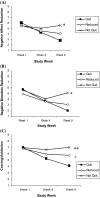Changes in smoking expectancies in abstinent, reducing, and non-abstinent participants during a pharmacological trial for smoking cessation
- PMID: 20644207
- PMCID: PMC2928936
- DOI: 10.1093/ntr/ntq120
Changes in smoking expectancies in abstinent, reducing, and non-abstinent participants during a pharmacological trial for smoking cessation
Abstract
Introduction: Smoking expectancies are related to smoking consumption and predict smoking cessation. Little is known about whether expectancies change during smoking treatments, consistent with changes in smoking behavior. This study examined reported changes in smoking beliefs during an 8-week smoking cessation trial, which evaluated the safety and efficacy of the monoamine oxidase B inhibitor selegiline hydrochloride versus placebo.
Methods: Participants were classified as "Quit" (n = 18), "Reduced" (n = 34), or "Not Quit" (n = 49) by 7-day point prevalence abstinence at the end of treatment. Expectancies were assessed at randomization, 1 week after the target quit date, and at the end of treatment.
Results: Beliefs about smoking assessed prior to the quit attempt were not associated with cessation outcomes. Participants who quit smoking reported a reduction in expectations that smoking would reduce negative affect, boredom, and cravings, and facilitate social interactions, while participants who did not quit smoking reported an increase in Negative Social Impression beliefs. There were gender differences in beliefs related to Negative Affect Reduction, Negative Physical Feelings, Social Facilitation, and Cravings and significant Gender X Smoking Status interactions for Health Risk and Weight Control beliefs. There were no significant effects of medication on expectancies.
Discussion: Baseline expectancies were not associated with abstinence outcomes; however, expectancies changed over time with changes in smoking, and the greatest changes were seen with smoking abstinence. Information about the relationship between smoking beliefs and behaviors may be used to enhance or tailor smoking cessation treatments.
Figures

References
-
- Biener L, Abrams DB. The Contemplation Ladder: Validation of a measure of readiness to consider smoking cessation. Health Psychology. 1991;10:360–365. - PubMed
-
- Brandon TH, Baker TB. The Smoking Consequences Questionnaire: The subjective expected utility of smoking in college students. Psychological Assessment. 1991;3:484–491.
-
- Brandon TH, Juliano LM, Copeland AL. Expectancies for tobacco smoking. In: Kirsh I, editor. How expectancies shape experience. Washington, DC: American Psychological Association; 1999. pp. 263–299.
-
- Chassin L, Presson CC, Sherman SJ, Edwards DA. Four pathways to young-adult smoking status: Adolescent social-psychological antecedents in a midwestern community sample. Health Psychology. 1991;10:409–418. - PubMed
-
- Cohen LM, McCarthy DM, Brown SA, Myers MG. Negative affect combines with smoking outcome expectancies to predict smoking behavior over time. Psychology of Addictive Behaviors. 2002;16:91–97. doi: 10.1037//0893-164X.16.2.91. - PubMed
Publication types
MeSH terms
Substances
Grants and funding
LinkOut - more resources
Full Text Sources
Medical

